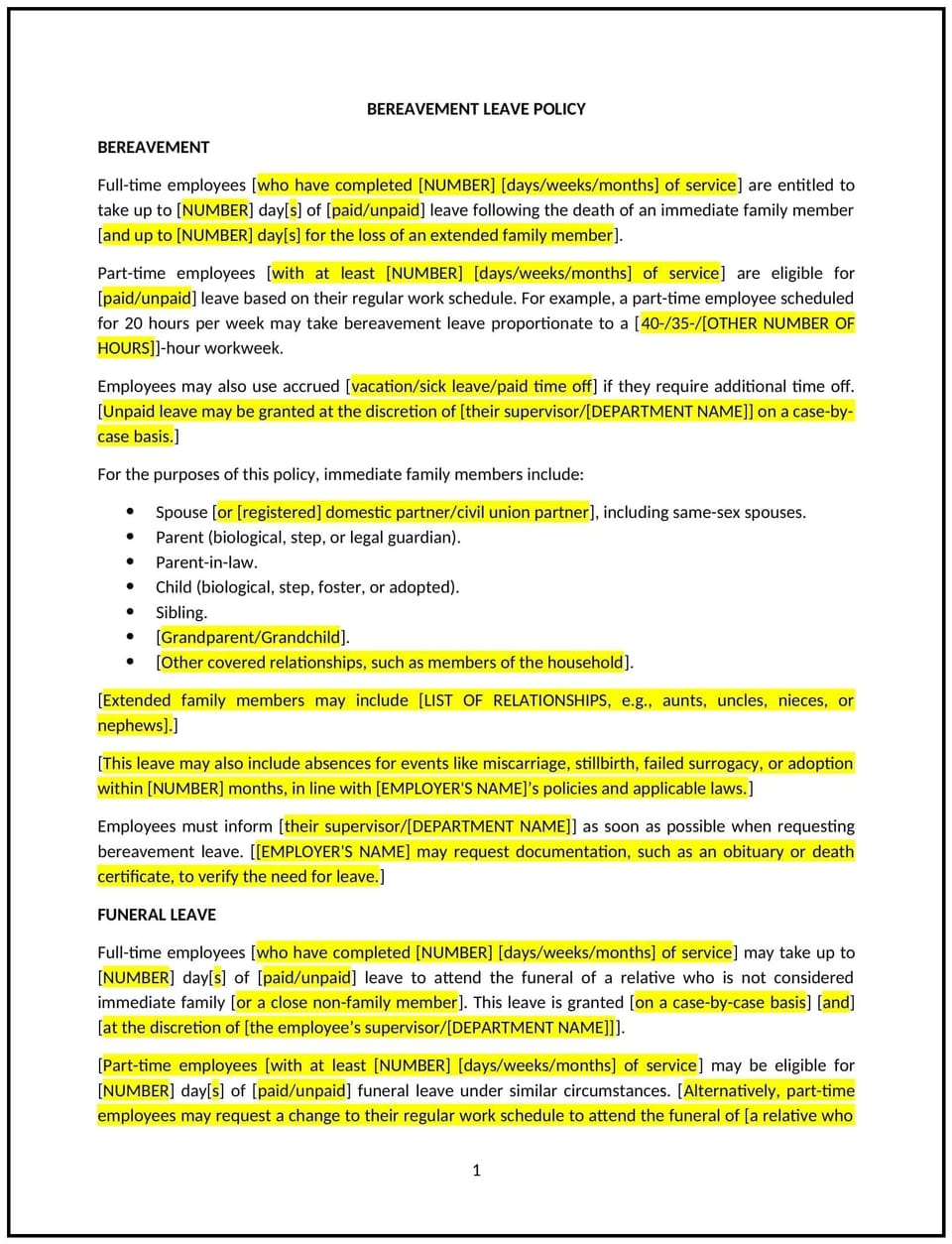Bereavement leave policy (Minnesota): Free template

Bereavement leave policy (Minnesota)
This bereavement leave policy is designed to help Minnesota businesses support employees during times of personal loss. Whether businesses are addressing the emotional needs of employees or maintaining workplace productivity, this policy provides a framework to offer compassionate and structured time off. Tailored to Minnesota’s workforce dynamics, this policy emphasizes empathy, flexibility, and respect for employees’ personal circumstances.
By implementing this policy, businesses in Minnesota can foster a supportive workplace culture, enhance employee well-being, and demonstrate care for their workforce.
How to use this bereavement leave policy (Minnesota)
- Define eligibility: Clearly outline which employees are eligible for bereavement leave, such as full-time, part-time, or temporary staff.
- Specify leave duration: Provide guidelines on the amount of leave employees can take, typically ranging from 1 to 5 days, depending on the relationship to the deceased.
- Include covered relationships: List the relationships that qualify for bereavement leave, such as immediate family members, extended family, or close friends.
- Establish notification procedures: Provide employees with clear instructions on how to request bereavement leave and whom to notify.
- Address paid vs. unpaid leave: Specify whether bereavement leave is paid or unpaid, in alignment with the business’s resources and policies.
- Encourage flexibility: Allow managers to grant additional time off or flexible work arrangements if needed, based on individual circumstances.
- Communicate the policy: Share the policy with employees during onboarding and through internal communications to ensure awareness and understanding.
- Review and update the policy: Regularly assess the policy’s effectiveness and make adjustments as needed to reflect changes in employee needs or business operations.
Benefits of using this bereavement leave policy (Minnesota)
This policy offers several advantages for Minnesota businesses:
- Supports employee well-being: Providing bereavement leave helps employees cope with personal loss and return to work with greater focus and emotional stability.
- Enhances workplace culture: A compassionate policy fosters a supportive and empathetic work environment.
- Builds trust and loyalty: Demonstrating care for employees during difficult times strengthens their commitment to the business.
- Reduces absenteeism: Structured leave policies help manage time off more effectively, minimizing disruptions to workflow.
- Improves morale: Employees feel valued when their personal needs are acknowledged and respected.
- Aligns with best practices: Offering bereavement leave reflects modern workplace standards and employee expectations.
- Strengthens reputation: A caring and supportive policy enhances the business’s reputation among employees and the community.
Tips for using this bereavement leave policy (Minnesota)
- Communicate the policy effectively: Share the policy with employees during onboarding and through regular reminders, such as emails or team meetings.
- Train managers: Educate supervisors on how to handle bereavement leave requests with empathy and consistency.
- Be flexible: Allow managers to grant additional time off or flexible work arrangements based on individual circumstances.
- Encourage open communication: Foster a culture where employees feel comfortable discussing their needs and requesting leave.
- Review the policy periodically: Update the policy as needed to reflect changes in employee needs, business operations, or industry standards.
- Document leave requests: Maintain records of bereavement leave requests to ensure consistency and fairness in application.
Q: Why should Minnesota businesses adopt a bereavement leave policy?
A: Businesses should adopt this policy to support employees during times of loss, enhance workplace culture, and demonstrate care for their workforce.
Q: Who is eligible for bereavement leave?
A: Eligibility should be clearly defined, typically including full-time, part-time, and temporary employees, depending on the business’s structure.
Q: How much bereavement leave should businesses provide?
A: Businesses should offer 1 to 5 days of leave, depending on the employee’s relationship to the deceased and individual circumstances.
Q: What relationships should be covered under the policy?
A: Businesses should include immediate family members, extended family, and close friends, depending on the business’s resources and culture.
Q: Should bereavement leave be paid or unpaid?
A: Businesses should specify whether leave is paid or unpaid, based on their resources and policies, while considering employee needs.
Q: How should employees request bereavement leave?
A: Businesses should provide clear instructions on how to request leave, including whom to notify and any required documentation.
Q: How often should the policy be reviewed?
A: The policy should be reviewed annually or as needed to reflect changes in employee needs, business operations, or industry standards.
This article contains general legal information and does not contain legal advice. Cobrief is not a law firm or a substitute for an attorney or law firm. The law is complex and changes often. For legal advice, please ask a lawyer.


